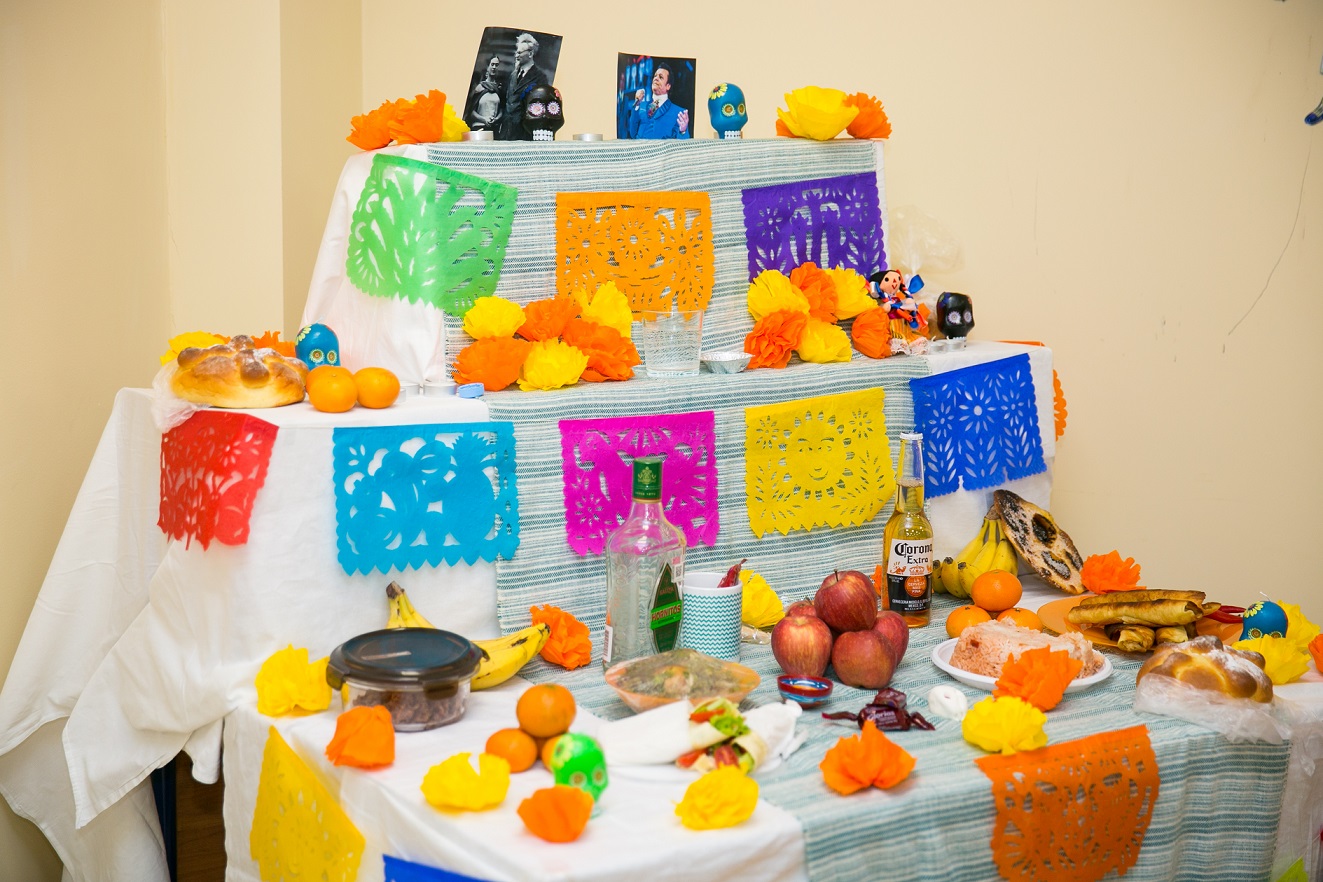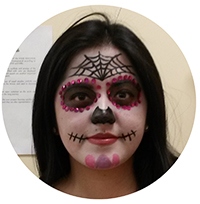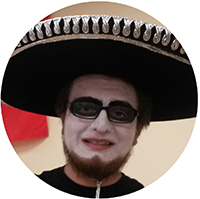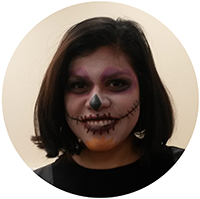Mexican Day of the Dead at HSE
On November 9, 2016 HSE held a Mexican Day of the Dead Celebration. The event was organized by the Mexican community at HSE and the International Student Support Unit with the support of the Embassy of Mexico in Russia.
The celebration was followed by the lecture on the Day of the Dead by the cultural attaché of the Embassy of Mexico Jorge Reynoso Pohlenz. He spoke about the history of the holiday, the traditions and the death theme in different cultures, especially in Mexican poetry and literature. HSE Vice Rector Ivan Prostakov thanked Mr. Jorge Reynoso Pohlenz after the lecture and presented him with a ceramic figure of a crow, which is an HSE mascot.
The lecture was also attended by the Consul of the Embassy of Mexico Manuel Flores Troche. He thanked HSE administration for supporting the initiatives of international students and organizing the events to promote their culture. It is worth mentioning that the embassy provided the students with the traditional costumes.
In Mexico the concepts of life and death are central to the country’s identity. The Day of the Dead festival lasts several days, and revolves around gatherings of family and friends to pray for and remember their loved ones who have died, and in so doing, to help support their spiritual journey.
The holiday, celebrated throughout the country, starts on October 25 or 28 and ends on November 2 or 3 depending on local traditions. In some regions the holiday, acknowledged internationally in many other cultures, is planned months in advance and celebrations can last up to a week, with each day honoring a particular relative or friend.
Day of the Dead vs. Halloween
Day of the Dead is not a Mexican version of Halloween, although both reference death, they radically differ in both traditions and attitude. While Halloween is a dark night on which people wear costumes to ward off ghosts, the Day of the Dead is filled with life-affirming joy, as people invite their deceased relatives to join them in celebration.
The event at HSE featured the main traditional elements of the celebration: altar called ofrenda, treats for guests, Mexican music and Catrina decorations and costumes.
Altar
Traditional altars created for the celebration are called ofrendas (Spanish for ‘offering’), and involve a collection of different symbolic objects, are usually set for a particular person who has died, and are intended to honor the ancestors and welcome the deceased to the altar.
The ofrenda is arranged on a table, covered with a white tablecloth and decorated with the papel picado (perforated paper) – craft made out of tissue paper cut into elaborate designs. Common themes for the holiday decorations include skeletons and the symbols of the four elements: earth, water, wind and fire (this last often represented by candles).

Interactive photo
A common ofrenda can nominally be divided into three levels. The top level identifies the deceased person who is invited to join the family for the celebration, and this level usually involves photos of the dead person along with the images of various saints and crucifixes. A candle, the light of which is supposed to guide the dead on their way back, is set for each deceased relative or friend. Water, a symbol of purity and cleanliness, is also put out on the ofrendas in order to quench the thirst of the souls, tired from their long journey.
Items intended to help the dead person to feel at home and welcome are put on the second level of the ofrenda. These may include the deceased’s favorite food, such as burritos, guacamole, red rice, tamales, fruits and chocolate, and their favorite things such as clothes, toys for children, and cigarettes or alcohol (usually tequila or beer) for adults. The souls of the deceased are not believed to eat the food, just to enjoy the aroma. A special place on the altar is devoted to pan de muerto – sweetened bread, baked and eaten only once a year and often decorated to look like finger bones.
The lowest level usually contains lit candles. Calaveras (decorated sugar skulls) and bright orange and yellow marigolds, representing the fragility of life, are strewn all over the altar. Vibrant colors and the scent of marigolds are thought to guide the souls to their altars.
La Catrina
La Calavera Catrina ('Elegant Skull') is an iconic figure in Mexican culture and is a central element in this celebration. The original Catrina was drawn in the early 20th century by famous Mexican printmaker, cartoon illustrator and lithographer José Guadalupe Posada, as a satirical portrait of upper-class Mexicans who denied their own cultural heritage and used heavy makeup to look pale, in an attempt to look like Europeans. While the original work by Posada introduced the character, the female skeleton owes her popularity, as well as the name ‘La Catrina,’ to the artist Diego Rivera, whose mural Sueño de una Tarde Dominical en la Alameda Central (Dream of a Sunday Afternoon Along Central Alameda) was created in 1947 and depicted famous people and events from Mexico’s history. Despite the initial ties with political satire, the image of Catrina – an elegant well-dressed skeleton woman – acquired great importance for Mexican culture as a whole, symbolizing not only the Day of the Dead but also Mexican relations with the death itself and their willingness to laugh at it and to accept it as it is, as regardless of people’s wealth, beauty or clothes, everyone is equal in death. Today, the image of Catrina has become extremely popular in mass culture, and people all over the world wear this white skeleton makeup while celebrating the Day of the Dead.
'We organized a celebration to share our culture with Russian students'
The exchange students who organized the celebration also shared their thoughts on the event and impressions of studying and living in Moscow with HSE news service:

Fernanda Baez Rodriguez, BA student
First we celebrated the Day of the Dead and arranged the altar in our dormitory, but then we thought of contacting international student support to help us set the altar in another building. We decided to share information about this, as it is one of the most beautiful celebrations in Mexico. At this time of year I really miss my family and feel homesick, as it is amazing time in Mexico with a very special atmosphere, time that you spend with your family. We decided to organize a celebration here to share our culture and traditions with Russian students. It is an important event for us, as we commemorate and remember our dead relatives and friends. We believe that on these days they come to us, their souls join us. We set an altar with their favorite foods, so the souls can smell it. It’s hard to explain it, but it’s a particular feeling, you really feel something special. You feel like your relatives are still alive.
This semester there are five exchange Mexican students at HSE. We live with other international and Russian students, and it’s really easy to communicate with them. We get to know more about each other’s cultures, and learn more about Russia. I have really great Russian friends. I even study Russian, it seems really difficult, now I can understand people very well, but it’s still hard for me to speak it. But I also have Russian friends who speak Spanish, who have visited Mexico, and I even teach some of my friends Spanish, so we communicate really well. Our countries are far away from each other and we don’t have enough information about Russian culture. I wanted to break the stereotypes, so I decided to come here.
Talking about stereotypes, when you hear about Russia, you think of cold, bears, matryoshkas, and that people here are always angry and never smile. That’s not true! Sure, Mexican people smile a lot, we are very friendly, and first it was unusual for me that in Moscow metro people don’t smile at you, but it’s just a stereotype that they are always angry: when you meet Russian people, become friends with them, they turn out to be the nicest people I’ve ever met.
As for another stereotype, people still believe that in Russia you can find bears on the streets, like they walk along the streets like dogs. I’ve been here for nine months – and still no bears!
Many foreigners also think that Russian people drink vodka from morning till night. Of course, they do drink it, but not like tea or for breakfast.
At the beginning I found it quite difficult because of the cold weather. I arrived in January 2016 (and I’ll go back home in January 2017), when it was really cold, up to 20 degrees below zero, so I got to adjust to this kind of weather, but then I liked it. Moscow is really beautiful, though life here is fast, it’s so different from the lifestyle of my home city. The city is huge, and I really like that in some parts you can see old buildings, Soviet ones, and then you go to Moscow city and see these modern skyscrapers.

Gustavo Arreola Camacho, MA student
The first and the second of November for me personally are the most important days of the year because in our family we put up our altar, the family gets together, we bake Pan de Muerte – the holiday traditional bread. Here, in Russia, we miss our traditions and our food, so we decided to do something about that and share our culture with the Russians, as this tradition is really interesting. There were some difficulties organizing the holiday as some of the decorations are hard to find in Moscow, but we managed to do it! We wanted to acquaint our Russian friends with our culture and also to learn more about Russian culture. I like Moscow, there are a lot of interesting buildings there, like Kremlin and Red Square, and every building has its own magic, I especially like the days when Moscow is all white, covered in snow, it’s really beautiful. I arrived here in August, so it wasn’t cold here, but I actually prefer cold weather, as when it’s cold you can just put on a warm coat and scarf and feel fine, but when it’s hot, there is nothing you can do about it. I study in English, but I’m also trying to learn Russian, it’s is difficult, as there is a mix of languages in my head, but it’s easy to communicate with other students.

Luisa Del Valle Franco, BA student
We have a lot of holidays in Mexico, we like to celebrate different things, although this celebration is the most important in our culture. It’s the most colorful, and is even compared to Halloween, though the holidays are totally different, as at Halloween you dress up to scare away dead people, while on our celebration we invite them in, we want them to join us, as we believe that we shouldn’t be scared of death.
First it was difficult for me to adjust to studying here, as the schedule is versatile, you study in different buildings. But our buddies really helped us get used to how things are here. I like Moscow, though I find it really cold. But the city is beautiful and the people are nice. I have some Russian friends and I communicate a lot with other international students.

